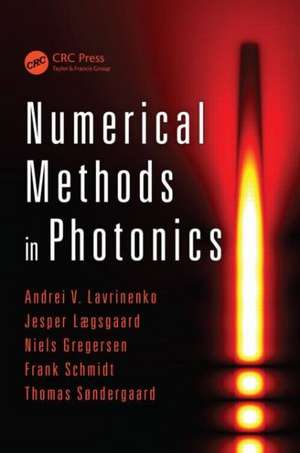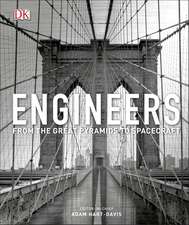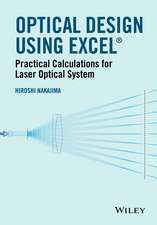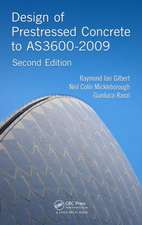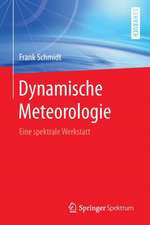Numerical Methods in Photonics: Optical Sciences and Applications of Light
Autor Andrei V. Lavrinenko, Jesper Lægsgaard, Niels Gregersen, Frank Schmidt, Thomas Søndergaarden Limba Engleză Hardback – 17 sep 2014
Choosing the appropriate computational method for a photonics modeling problem requires a clear understanding of the pros and cons of the available numerical methods. Numerical Methods in Photonics presents six of the most frequently used methods: FDTD, FDFD, 1+1D nonlinear propagation, modal method, Green’s function, and FEM.
After an introductory chapter outlining the basics of Maxwell’s equations, the book includes self-contained chapters that focus on each of the methods. Each method is accompanied by a review of the mathematical principles in which it is based, along with sample scripts, illustrative examples of characteristic problem solving, and exercises. MATLAB® is used throughout the text.
This book provides a solid basis to practice writing your own codes. The theoretical formulation is complemented by sets of exercises, which allow you to grasp the essence of the modeling tools.
| Toate formatele și edițiile | Preț | Express |
|---|---|---|
| Paperback (1) | 427.16 lei 6-8 săpt. | |
| CRC Press – 22 noi 2017 | 427.16 lei 6-8 săpt. | |
| Hardback (1) | 1123.34 lei 6-8 săpt. | |
| CRC Press – 17 sep 2014 | 1123.34 lei 6-8 săpt. |
Preț: 1123.34 lei
Preț vechi: 1369.92 lei
-18% Nou
Puncte Express: 1685
Preț estimativ în valută:
214.96€ • 225.46$ • 178.94£
214.96€ • 225.46$ • 178.94£
Carte tipărită la comandă
Livrare economică 01-15 aprilie
Preluare comenzi: 021 569.72.76
Specificații
ISBN-13: 9781466563889
ISBN-10: 1466563885
Pagini: 364
Ilustrații: 96 black & white illustrations, 3 black & white tables
Dimensiuni: 156 x 234 x 25 mm
Greutate: 0.86 kg
Ediția:1
Editura: CRC Press
Colecția CRC Press
Seria Optical Sciences and Applications of Light
Locul publicării:Boca Raton, United States
ISBN-10: 1466563885
Pagini: 364
Ilustrații: 96 black & white illustrations, 3 black & white tables
Dimensiuni: 156 x 234 x 25 mm
Greutate: 0.86 kg
Ediția:1
Editura: CRC Press
Colecția CRC Press
Seria Optical Sciences and Applications of Light
Locul publicării:Boca Raton, United States
Cuprins
Introduction. Maxwell’s Equations. FDTD. Finite-Difference Modeling of Straight Waveguides. Modeling of Nonlinear Propagation in Waveguides. The Modal Method. Green’s Function Integral Equation Methods for Electromagnetic Scattering Problems. Finite Element Method.
Notă biografică
Andrei V. Lavrinenko, Technical University of Denmark, Kongens Lyngby
Jesper Lægsgaard, Technical University of Denmark, Kongens Lyngby
Niels Gregersen, Technical University of Denmark, Kongens Lyngby
Frank Schmidt, Zuse Institute, Berlin, Germany
Thomas Søndergaard, Aalborg University, Denmark
Jesper Lægsgaard, Technical University of Denmark, Kongens Lyngby
Niels Gregersen, Technical University of Denmark, Kongens Lyngby
Frank Schmidt, Zuse Institute, Berlin, Germany
Thomas Søndergaard, Aalborg University, Denmark
Recenzii
"… useful to students and researchers who want to have a deeper understanding of the methods commonly used in computational electromagnetics. After addressing the basic principles, this book provides the readers with the details and mathematical/numerical framework of commonly used methods including FDTD, finite element, Green’s function, and modal. It then goes on to more advanced topics such as modelling nonlinear materials and materials with gain. This book is a useful addition to the library of any research university."
—C T Chan, Hong Kong University of Science and Technology
—C T Chan, Hong Kong University of Science and Technology
Descriere
Choosing the appropriate computational method for a photonics problem requires a clear understanding of the pros and cons of the available numerical methods. This book presents six of the most frequently used methods: FDTD, FDFD, 1+1D nonlinear propagation, modal method, Green’s function, and FEM. Each method is accompanied by a review of the mathematical principles in which it is based, along with sample scripts, illustrative examples of characteristic problem solving, and exercises. MATLAB® is used throughout the text.
